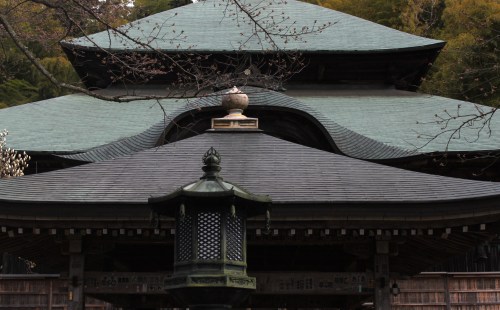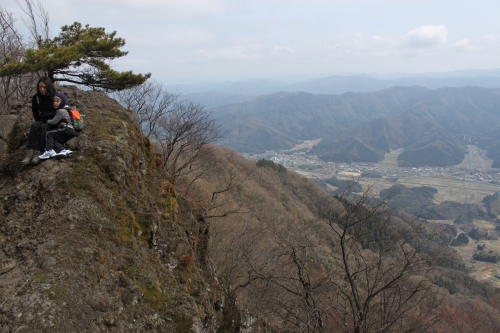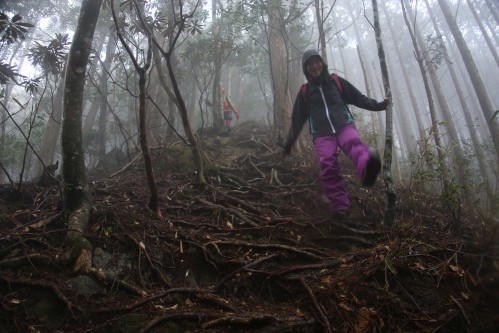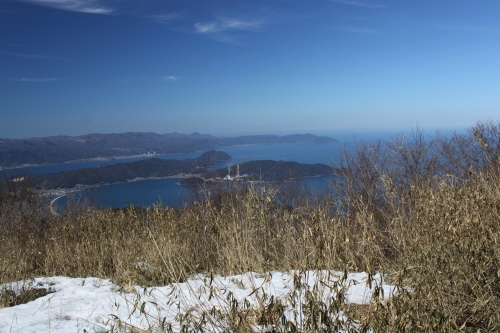The next morning I awoke around 9am with sore shins and a stiff back. I cooked up an omelette in the hostel kitchen and marched up the main road a short time later, this time in route for the summit of Mt. Mihara. This was my second sea to summit attempt in as many days. My target peak sits directly opposite Hachijō-fuji, offering the opportunity to have a head-on view of the perfect cone that draws hoards of mountaineers to her curvy slopes. It took about a half an hour to reach the forest road that would lead up to the trailhead, but I headed a bit further to a supermarket in search of lunch and other provisions. After that quick detour, I found the deserted road that wound its way through the jungle up towards the ridge. The first thing that came into view was a sign indicating that the forest road was closed to all thru-traffic due to construction, but surely the road crew would be taking a beautiful Sunday off to enjoy the village festival that was now in full swing.

It took about thirty minutes to reach the construction zone, and low and behold the place was alive with crews preparing the road for resurfacing. They were also putting finishing touches on a sparkling new web of concrete on the hillside that resembled a Belgian waffle. You’ll find these erosion control devices in every prefecture of Japan, but I was a bit taken aback by the scale of the frenetic work until I remembered the calendar. It was the end of March, the time when all of the prefectural governments must spend their yearly budget money, so the public works projects are at their most hectic in these final days of the fiscal year. This is especially true at the current time, with the prime minister’s Abenomics initiative to kick-start the economy by investing unprecedented money into needless public works projects that his forefathers in the LDP were so efficient at setting up through the years.

To add insult to injury, further up the road to nowhere stood a cedar plantation carved out of the jungle foliage. Alas, my plan to escape the pollen by heading to this remote island was foiled after all. The only remedy for my frustration was a one-fingered salute backed by a chorus of expletives.

Eventually, I did find a signpost pointing towards the summit of Mt. Mihara on the left side of the road, but for now the trail remained disguised as a concrete escarpment that terminated at a towering antenna erected by the kind folks at NTT. It was here that the path to the ridge truly began, and in grand fashion no doubt, by way of a series of moss-laden concrete steps that put the pumice steps at Hachijō-fuji to shame. What was I doing up here?

After a few thousand steps, the trail did indeed breach the ridge, where a small signpost pointed the way to NHK of all places. The views did open up towards Fuji, which was now in the process of being swallowed in that familiar dark cloud. To my right, condensation drifted up from the southern part of the island threatening to engulf the summit of Mihara which stood directly in front of me. I stepped on the gas pedal, reaching the summit plateau where two antenna stood proudly on the wind-swept grasslands. A few meters higher sat the official high point, 700 meters above the ocean that was floating somewhere out there beyond this cloak of fog.
I retreated back out of the cloud like a dog with its tail between its legs. This fickle island weather was not making a good impression on this seasoned mountaineer. It was time for a change. Once back at the main road, I turned left and followed the automobiles and volunteer staff manning the intersections to the village office, where the local festival was reaching crescendo. Booths hawking local delicacies lined the interior of the multi-purpose hall, while a side room had island flora on display from some of the talented flower arrangers that call this isolated isle their home. Outside, men in green vests pounded mochi while another tent on the opposite side of the large open plaza served miso soup to a handful of elderly residents relaxing in the shade. I filled my belly with every free sample that I could get my hands on before eventually completing the exhausting walk back to the hostel.
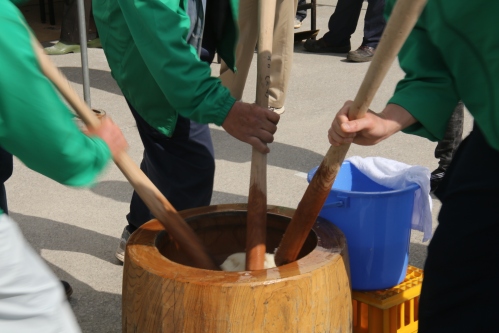
The following day was my last on this island, and I proclaimed that there would be no more hiking. For one, I had climbed the only two mountains around, and two, I was in desperate need of a bath. The local bus circling the island provided motorized transport this time around, and I settled into an outdoor bath perched high on a plateau overlooking the mighty blue waters of the Pacific. Surely this must be the best bath among all of the Izu Islands, if not the Kanto region itself. It was an ample way to finish off my sojourn, with two mountains and two hot springs that left a favorable impression. Is Hachijō island the perfect weekend getaway for nature-starved Tokyoites? Perhaps, but Kansai residents may find better solace in seeking out the hidden coves of the Tango Peninsula in northern Kyoto.

Still, the short foray into those secluded islands of Tokyo whet my appetite for volcanic exploration. I vowed to make a return visit, next time to the sulfur-spewing flanks of Miyakejima as well as the tufted highlands of Kozushima.







